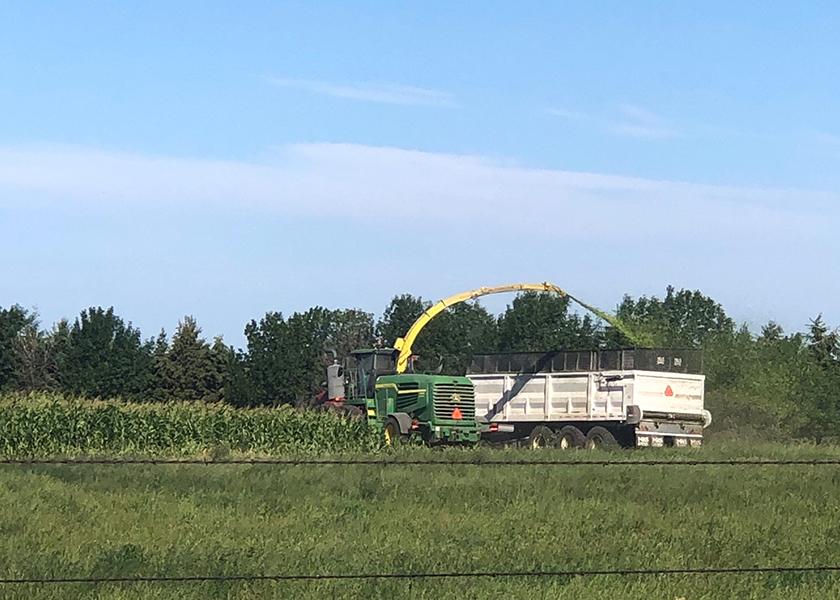Moisture Matters When Making Good Corn Silage

Salvaging this year’s corn crop as silage can help crop producers recoup some production costs while providing good-quality feed for livestock.
Drought-stressed, limited grain-filled corn silage still can retain a majority of its feeding value, North Dakota State University Extension specialists say.
Whole-plant moisture and the plant’s maturity at harvest affect corn silage quality, according to Kevin Sedivec, NDSU Extension rangeland management specialist. Drought slows plant growth and delays maturity, leading to a higher moisture content than indicated by the appearance of the corn.
“The moisture content can vary in your field based on the level of drought and the corn hybrid,” Sedivec says. “With many new corn varieties selected for the ‘stay-green’ trait, visual estimates can be quite variable, based on environment and management.”
Making silage when the corn is too dry results in poor packing, inadequate air exclusion, poor fermentation and heating. Dry silage creates higher levels of spoilage and low bunk life.
“With poor harvest and management, these losses can be in excess of 50%,” Sedivec notes. “Therefore, proper harvest and management is important to ensure you are maximizing the amount of good-quality silage available for feeding your livestock.
“Making corn silage requires moisture for proper fermentation to minimize dry-matter loss and spoilage,” he adds. “Ensiling at the correct whole-plant moisture content and optimum plant maturity is critical.”
Corn should be harvested for silage at a moisture content of 65% to 70% when using a horizontal bunker. If too wet - above 70% - yield potential is reduced and seepage will occur, resulting in the undesirable presence of clostridia bacterial fermentation. In a recent study conducted at NDSU’s Central Grasslands Research Extension Center, ensiling at 60% moisture still produced high-quality silage.
Seepage results in a loss of nutrients that can be harmful to the environment and can allow feed to freeze during the winter.
Clostridia bacteria are very inefficient, converting forage sugars and organic acids into butyric acid, carbon dioxide and ammonia. Silage with these bacteria loses dry matter, creates a foul smell due to the butyric acid and has a higher pH, and poor forage quality and palatability.
“Drought-stressed corn with the bottom four to seven leaves brown and dry was at the proper moisture content for silage fermentation,” Sedivec says. “This silage would have no cobs and would be lower in production and energy content but may have slightly higher crude protein and fiber, compared with corn silage with grain.”
Testing Moisture Content of the Field
A microwave can be used to check the moisture content of corn silage. Be sure not to use the microwave in your house because drying the corn may produce a strong odor.
In addition to a microwave, you will need a scale that reads in grams. Collect a silage sample or collect several corn plants representative of the field and chop them into 1-inch pieces. Measure 100 grams of the sample and record the weight of the wet sample. Then dry the sample in a microwave for only a few minutes.
When drying, be sure to include a glass of water so the dried feed doesn’t start a fire in the microwave. Check the weight of the dried sample and repeat drying the sample in the microwave until the sample weight does not change more than 1 or 2 grams.
Calculate the moisture weight by subtracting the dry weight from the wet weight. Divide the moisture weight by the initial wet weight and multiply by 100 to get the moisture content.
For example, 102 grams (wet sample) minus 34.6 grams (dry sample) = 67.4 grams (moisture weight); 67.4 (moisture weight) divided by 102 (wet weight) = 0.6607 x 100 = 66.07% moisture.
Proper Management of Silage
“A critical step to ensure good-quality silage is the packing process,” says Zac Carlson, NDSU Extension beef cattle specialist. “An anaerobic environment is required for appropriate silage fermentation, and packing removes air between silage particles.”
Adequate packing involves a number of factors, including the correct chop length for a particular silage crop, as well as having the appropriately sized tractor for the amount of silage being placed in the pile. Because wheeled tractors exert more pressure per square inch, compared with crawler or track-type tractors, wheeled tractors are preferred for packing silage.
“Excess air remaining between particles (poor packing) leads to excess spoilage and mold growth,” Carlson says. “Producers need to be efficient in minimizing feed losses, particularly this year with high feed prices and limited feedstuff availability.
“Once piles are well-packed, consider covering the pile to enhance silage quality further and reduce spoilage,” he advises. “Remember that the amount of visible spoilage seen on top of piles (up to 16 inches in a survey of producers) is wasted feed.
“Considering the high variability in quality due to harvest conditions, harvest methods and ensiling methods, we recommend that producers test forage quality to ensure they are meeting animals’ nutritional requirement,” he adds.







